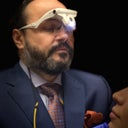Thank you for your question ebn. I understand your concern. Botox is a purified protein used to address wrinkles associated with facial expression. When injected into the skin Botox will relax the muscles and smoothen out the overlying wrinkles. The most common areas of treatment are in the upper face. These include the horizontal lines seen on the upper forehead when one raises the brows, the vertical lines seen between the brows when one frowns (frown lines), and the crow's feet seen around the eyes when one smiles.It is difficult to make an assessment without a formal exam where the entire medical history is reviewed. However, I hope the information provided here is useful.The safety record of Botox is well established. The product has been used for over 20 years for a variety of treatments with minimal side effects. Botox is amongst the safest treatments for treating facial wrinkles.While Botox is one of the safest treatments offered, there are some situations where it is not appropriate. These include anyone who has an allergy to any of the inactive ingredients or who has had an allergic reaction to any botulinum product including Botox, Dysport, Xeomin, or Myobloc. The safety and efficacy of Botox has not been established in women who are pregnant, trying to become pregnant, or breast feeding. Therefore, women in these categories are advised to wait until breast feeding is completed prior to having a Botox treatment. Botox should not be placed in the skin on the site of an infection. Those who are taking an aminoglycoside antibiotic, an anesthetic, D-penicillamine, antimalarials, or immunosuppressants should not be treated, nor should those who have undergone chemotherapy within the previous six months. It is important to avoid blood thinners before and after a treatment. These include both prescription and non-prescription medications such as warfarin (coumadin), aspirin, ibuprofen, alcohol, fish oil, vitamin E, and ginko biloba. Those with conditions that affect muscles and nerves such as amyotrophic lateral sclerosis (ALS or Lou Gehrig's disease), myasthenia gravis, or Lambert-Eaton syndrome should not undergo Botox treatments.Botox does not contain sulfa. Therefore it is safe to administer Botox to those with a sulfa allergy, assuming there are no other contraindications.With any injection, there are risks such as pain, bleeding, bruising, redness, swelling, tenderness, and infection. We take special precautions to minimize these risks such as using a painless technique. We also treat bruises with a laser as early as the next day. Bruises usually resolve within two weeks if untreated. After a laser treatment bruises usually resolve in 1-3 days, but may still take two weeks for full resolution. In addition to these risks, with Botox there is also a risk that the product spreads or diffuses to nearby structures. Spread to nearby muscles can lead to side effects such as the temporary appearance of droopy eyelids or a temporary asymmetric smile.






